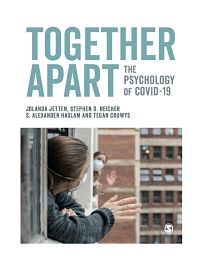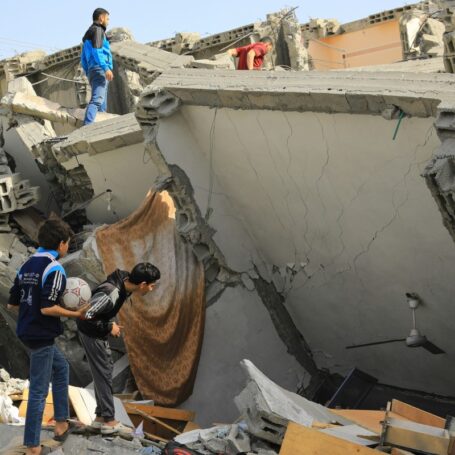Looking at Emergencies and Disasters During COVID: Excerpt from ‘Together Apart’
Over the last 50 years, we have come to know quite a lot about how people behave in emergencies and disasters. Using a variety of methods, research by sociologists and psychologists has identified a number of consistent features. This research has explored behaviour in diverse crises such as fires, earthquakes, floods, storms and other natural disasters, as well as terrorist attacks. The COVID-19 crisis is different from these events in important ways. It comprises multiple incidents spread out over several months; and its effects are dispersed across the world rather than concentrated on a single group of people. Nevertheless, there are important similarities: there is a mortal threat which can create fear; there is not enough protection for everyone under threat; and human action can mitigate (or exacerbate) that threat.
Understanding human behaviour in emergency events can therefore provide insights into behaviour during the COVID-19 pandemic. Nevertheless, some might ask why we need all that research? Don’t we already know how people behave under conditions of mortal threat, inadequate protection, and extreme fear? They panic!

What exactly do people mean by the term panic? There are various definitions, but one thing that reliably distinguishes the concept of ‘panic’ from related constructs such as fear and flight is the notion of over-reaction. It implies that the things people feel and the ways they act are excessive. A person suffering from panic has anxiety and fear reactions that are out of proportion with reality. So, to claim that people panic in an emergency is to claim that they over-react to the threat posed by the emergency.
What is more, the concept of panic incorporates an explanation for why people over-react. It is down to being in a crowd. Drawing on Le Bonian ideas (see Chapter 12), the supposition is that people have lost their minds, and the fear of each person ‘infects’ others through the process of contagion, heightening fear levels until they bear little relation to the original stimulus. But in an emergency, how do we establish whether fear is ‘excessive’? At the time, there is generally so much uncertainty it is impossible to know how significant the danger is. In retrospect it is easier to judge — because one can then sift the evidence to determine what was not known at the time. Precisely because of this, after the event it is no longer possible to judge if people acted reasonably.
For example, in the early days of the COVID-19 crisis, was the extra shopping that some people engaged in (so called ‘panic buying’) necessarily excessive? By what criteria? If someone believes (a) that they may be forced to stay at home for an extended period in the near future, and/or (b) that other people will soon clear the shelves, then it makes perfect sense to buy extra oneself. It may be excessive from the perspective of the community, but not necessarily from the perspective of the actor (Luscombe, 2020). Most disaster researchers have therefore abandoned trying to judge whether behaviour in such events is rational or irrational, and have recommended focusing instead on what people do and why they do it.
Responses to danger are largely sensible
In most emergencies, people need to respond urgently — usually by fleeing as quickly as possible. But instead, their response is often delayed. This is most evident in research on fires, but the same is also true for bombings and various natural hazards such as earthquakes, hurricane and floods. In fact, it is this under-reaction, rather than ‘panicked’, over-reaction that is the major cause of fatalities in a crisis. In line with the general conception of psychological frailty (see Chapter 1 and 5), this tendency has sometimes been put down to a generalised ‘optimistic bias’ in human judgement (e.g., Kinsey et al., 2019).
Once again, such accusations rest on the benefit of hindsight. After all, emergency events are exceedingly rare, and if one fled at every sign of possible danger one would waste an awful amount of time and energy. At the time, it is often reasonable to interpret such signs in more mundane terms. Moreover, one is highly dependent upon the interpretation provided by others. Often, the problem lies less with the psychology of the public than with the failure of authorities to identify danger signs and give clear guidance as to how to respond. In the present pandemic, many would argue that fault lies in the hands of those governments which were slow to identify the risks posed by COVID-19 and to introduce appropriate responses such as physical distancing and lockdown (e.g., Mason, 2020, see also Chapter 18).
A further problem with the notion of ‘optimistic bias’ is that, in cases where threat becomes more frequent, the notion that “this can’t be happening to us” quickly starts to reverse. For example, in 2017, after a series of terrorist attacks in London, hundreds of people in Oxford Street fled from a noise that turned out to be harmless.
Solidarity is the rule, not the exception
On the whole, the most striking feature of emergencies is the emergence of social support and cooperation. This is true not in every emergency and not for every person in every emergency, but often enough to be mentioned again and again in studies of specific events (Solnit, 2009). Importantly, in a disaster, solidarity goes beyond those who are directly affected. Strangers stop to offer help to those they witness in difficulty (Levine & Manning, 2013). People tend to “converge” to the location of disasters — some simply to look, but many to help, even if they do not have specialist skills. Indeed, more lives are saved by the “average” citizen, whether “bystander” or fellow survivor, than by professionals (Helsloot & Ruitenberg, 2004).
Solidarity also outlasts the emergency itself. Many emergencies and disasters involve inequality and injustice — the disaster itself is often a result of inequality, and those already disadvantaged suffer disproportionately (United Nations Office for Disaster Risk Reduction, 2015; see Chapter 17). Accordingly, survivors and bereaved often seek redress, and the ‘disaster communities’ that arise in the immediate aftermath of crises can evolve to try to meet people’s needs for justice. This has been observed after disasters as diverse as the 1985 Mexico City earthquake (Solnit, 2009), the 2011 Fukushima nuclear disaster in Japan (Aldrich, 2013) and the 2017 Grenfell fire in London (Charles, 2019; Tekin Guven & Drury, 2020). As the Grenfell United campaign shows, such justice campaigns create yet further solidarities, receiving support from other campaigns and broadening their remit to address other injustices (Renwick, 2019).
The story of COVID-19 is much like the story of disasters in general. Certainly one can find examples of selfishness: people stockpiling scarce resources like toilet paper, profiteering from hand sanitizer, or ignoring lockdown to drink with their friends. But the frequency of such behaviour was greatly exaggerated by a media which loves nothing more than a story of transgression (D’Urso, 2020; Reicher et al., 2020).
However, as indicated in Chapter 1, the real headline of the pandemic — at least in its first phases — has been the extent of adherence to unprecedented restrictions, notably lockdown (e.g. ONS, 30th April 2020). This in itself is an indication of solidarity, because most people stayed at home less to protect their own health than to minimise the risk of spreading the disease and harming those who were vulnerable (Jackson et al., 2020).
Additionally, virtually everyone has been involved in some informal act of solidarity — knocking on a neighbour’s door to see if they need anything, helping with shopping, setting up WhatsApp groups for one’s street, or simply being friendly to others (Monbiot, 2020; see also Chapter 7). There has also been a remarkable flowering of more formal forms of solidarity. In the U.K. alone, some one million people volunteered to help the NHS and over four thousand mutual aid groups have been formed, involving over three million people. There have been so many offers of solidarity that there has sometimes not been enough for people to do (Butler, 2020).
Solidarity trumps selfishness
As psychologists, when we are asked how people behave in emergencies and disasters, the hope and expectation is often that there is a simple answer reflecting a general human nature. The ‘panic’ narrative persists partly because it satisfies that desire. We have argued in this chapter that things are more complicated than this perspective suggests. People can react selfishly, but — as we have shown here — they often respond with solidarity. We have seen in this in the wake of COVID-19. Most importantly, though, as psychologists, our aim is not to speculate about how people will act; rather, we seek to identify the factors and understand the processes which determine whether selfishness will trump solidarity or vice-versa. In this way, we are more able to shape what will happen. So, what are these processes? That is the subject of the next chapter.
Explore This Theme
Introduction to Collective Behaviour
Crowds | Fergus Neville and Stephen D. Reicher
An outline of both traditional and contemporary models of collective behaviour.
Emergencies and disasters | John Drury and Selin Tekin Guven
How people behave in crises, mapping the emergence of widespread solidarity
Solidarity | Evangelos Ntontis and Carolina Rocha
Exploring the psychological underpinning of such solidarity, providing evidence for the critical role of shared social identity.
Managing crowds in crises | Holly Carter, Dale Weston and Richard Amlôt
Looking at emergency services and their relation with the public
Social order and disorder | Clifford Stott and Matt Radburn
Examining the nature of police–public encounters in determining whether the public stay united and orderly




























































































